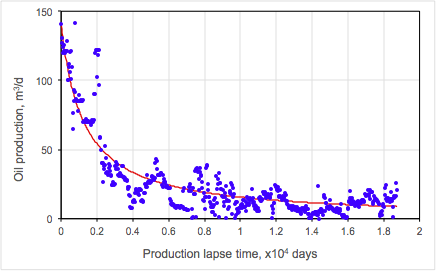Specific type of production rate q(t) decline:
|
|
|
|
where
q_0 = q(t=0) | Initial production rate of a well (or groups of wells) |
D_0 > 0 | initial Production decline rate |
\displaystyle Q(t)=\int_0^t q(t) \, dt | cumulative production by the time moment t |
Q_{\rm max} =\int_0^{\infty} q(t) \, dt | Estimated Ultimate Recovery (EUR) |
\displaystyle D(t) = - \frac{dq}{dQ} | Production decline rate |
It can be applied to any fluid production: water, oil or gas.
Harmonic Production Decline is an empirical correlation for production from the infinite-reserves Q_{\rm max} = \infty reservoir.
The Production decline rate is starting at its maximum D_0 and then gradually reduces to zero.
This usually happens at early stages of production when the total reservoir volume is not yet engaged.
Although the anthropogenic restriction of production in mature fields may lead to a similar behaviour.
The Harmonic decline is also observed at the mature stage of waterflood projects.
A typical example of various fitting efforts of Harmonic Production Decline are brought on Fig. 1 – Fig. 3 with harmonic fitting being a clear winner.
| Fig. 1. Exponential best ft to Harmonic Production Decline | Fig. 2. Hyperbolic best ft to Harmonic Production Decline | Fig. 3. Harmonic best ft to Harmonic Production Decline |
See Also
Petroleum Industry / Upstream / Production / Subsurface Production / Field Study & Modelling / Production Analysis / Decline Curve Analysis


